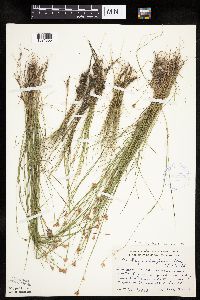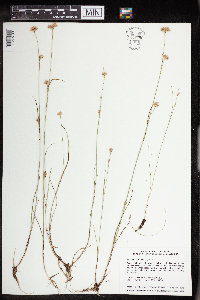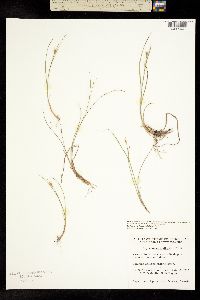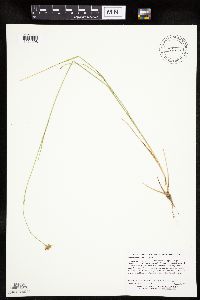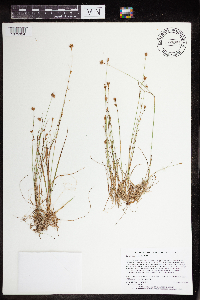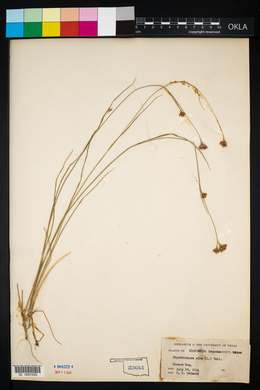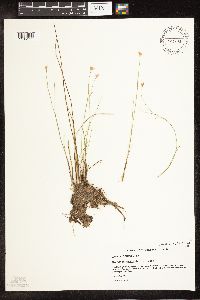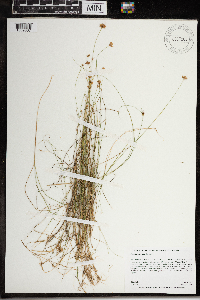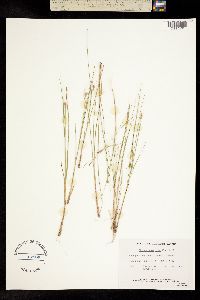Rhynchospora alba
|
|
|
|
Family: Cyperaceae
White Beak Sedge, more...white beaksedge
[Rhynchospora alba f. laeviseta Gale] |
Plants perennial, densely cespitose, 6-75 cm; rhizomes mostly absent. Culms erect to curved, leafy, obscurely trigonous to nearly terete, few ribbed, slender. Principal leaves mostly overtopped by culm; blades narrowly linear to filiform, proximally flat, 0.5-1.5 mm, apex tapering, trigonous. Inflorescences: clusters 1 or 2-3, then widely spaced, narrowly turbinate to hemispheric, 1.5-2.5 cm wide; subtending leafy bracts often exceeded by distal cluster. Spikelets pale brown to nearly white, ellipsoid, 3.5-5.5 mm, apex acute; fertile scales elliptic, 3-3.5(-4) mm, apex acute or acuminate, midrib excurrent as mucro. Flowers: perianth bristles 10-12, slightly overtopping tubercle, retrorsely barbellate or rarely smooth, base often setose. Fruits 1(-2) per spikelet, (2.3-)2.5-3 mm; body pale brown with paler center, stipitate obovoid, lenticular, 1.5-1.8(-2) × 0.9-1.2 mm; surfaces transversely striate, relatively smooth, rim narrow, flowing to tubercle base; tubercle narrowly triangular subulate, 0.5-1.2 mm. Fruiting summer-fall. Acid, sphagnous, boggy, open sites, poor fens, often on floating mats or peaty interstices of rocky shores; 0-2000 m; Alta., B.C., Man., N.B., Nfld. and Labr. (Nfld.), N.W.T., N.S., Ont., P.E.I., Que., Sask.; Alaska, Calif., Conn., Del., Fla.(-), Ga., Idaho, Ill., Ind., Maine, Md., Mass., Mich., Minn., N.H., N.J., N.Y., N.C., Ohio, Oreg., Pa., R.I., S.C., Tenn., Vt., Va., Wash., W.Va., Wis.; West Indies (Puerto Rico); South America(-); Eurasia. The smooth-bristled Rhynchospora alba forma laeviseta Gale mostly occurs with the typical antrorsely barbellate type in Pennsylvania, the Great Lakes, British Columbia, Newfoundland, and Nova Scotia.
Perennial herb, densely tufted 6 cm - 0.7 m tall Leaves: alternate, three-ranked, 0.5 -2.5 mm wide, flat basally, becoming three-angled, narrowly linear to thread-like with a tapering tip, parallel-veined, with a sheathing base that encloses the stem. Sheaths opening at the top. Inflorescence: a terminal head of one to three spikelet clusters, 1 - 2.5 cm wide, reverse cone-shaped to hemispheric, subtended by leaf-like bracts. Flowers: minute, subtended by a floral scale, lacking sepals and petals, bearing ten to fourteen bristles. Bristles in two rows, stout, flattened, often minutely bristly at the base. Stamens exserted. Pistil one. Style two-cleft. Fruit: a one-seeded achene, one or two per spikelet, stalked, light brown with a lighter center, 1.5 - 2 mm long (not including tubercle), about 1 mm wide, reverse egg-shaped with a contracted base, biconvex, more or less smooth. Tubercle 0.5 - 1 mm long, thinly triangular. Culm: curved to upright, 6 cm - 0.7 m long, overtopping leaves, thin, obscurely three-sided to nearly circular in cross-section, ribbed, solid, leafy. Spikelets: white to light brown, 3.5 - 5.5 mm long, ellipsoid with a pointed apex, with two or three flowers. Floral scales spirally arranged and overlapping, 3 - 3.5 mm long, elliptic with a pointed apex that bears a small point. Similar species: No information at this time. Flowering: late June to late September Habitat and ecology: Locally frequent in bogs. Also found in marly fens. Occurence in the Chicago region: native Etymology: Rhynchospora comes from the Greek words rhynchus, meaning beak, and spora, meaning seed, referring to the beaked achene. Alba means white. Author: The Morton Arboretum Erect perennial to 7 dm, the clustered, very slender stems usually overtopping the lvs, these 0.5-2.5 mm wide; glomerules 1-3, broadly turbinate, 6-20 mm thick, the uppermost barely or scarcely surpassed by its bracts, the lateral ones usually remote and long-pedunculate; spikelets 4-5 mm, whitish, becoming pale brown, with 2(3) fls and 1 or 2 frs; bristles 8-14, biseriate, stout, flattened, about equaling the tubercle, usually retrorsely barbellate, often minutely antrorse-hairy at base; achenes flattened-pyriform, 1.5-2 mm, contracted at base, brownish-green with very faintly transverse brown lines; tubercle subulate, half to two-thirds as long as the achene; 2n=26, 42. Sphagnum- bogs and open conifer-swamps; circumboreal, s. to N.C., O., n. Ind., Minn., and Calif. Gleason, Henry A. & Cronquist, Arthur J. 1991. Manual of vascular plants of northeastern United States and adjacent Canada. lxxv + 910 pp. ©The New York Botanical Garden. All rights reserved. Used by permission. From Flora of Indiana (1940) by Charles C. Deam Mostly in the lake area. Infrequent in sedge marshes and bogs, usually on the borders of lakes. …… Indiana Coefficient of Conservatism: C = 10 Wetland Indicator Status: OBL |
|
|
|
























